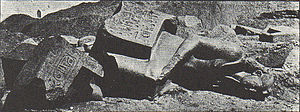Imyremeshaw
| Imyremeshaw | |
|---|---|
| Imyremeshau, Mermeshau, Emramescha' | |

|
|
| Pharaoh | |
| Reign | less than 10 years, starting 1759 BC or 1711 BC(13th Dynasty) |
| Predecessor | Khendjer |
| Successor | Sehetepkare Intef |
| Consort | uncertain, possibly Queen Aya |
| Monuments | uncertain, possibly an unfinished pyramid at Saqqara neighboring that of Khendjer |
Smenkhkare Imyremeshaw was an Egyptian pharaoh of the mid 13th dynasty during the Second Intermediate Period. Imyremeshaw reigned from Memphis, starting in 1759 BC or 1711 BC. The length of his reign is not known for certain; he may have reigned for 5 years and certainly less than 10 years. Imyremeshaw is attested by two colossal statues now in the Egyptian Museum, Cairo.
Imyremeshaw is attested on the Turin canon, on column 7, line 21 (Alan Gardiner's entry 6.21) as [Smenkh]kare Imyremeshaw. The main contemporary attestations of Imyremeshaw are a pair of colossi dedicated to Ptah "He who is south of his wall, Lord of Ankhtawy" (rsy-snb=f nb ˁnḫt3wy), a Memphite epithet indicating that the statues must originally have been set up in the temple of Ptah in Memphis. The colossi were later usurped by the 15th dynasty Hyksos ruler Aqenenre Apepi who had his name inscribed on the right shoulder of each statue with a dedication to "Seth, Lord of Avaris" and had the statues placed in his capital, Avaris. Later, the colossi were moved to Pi-Ramesses by Ramses II who also had his name inscribed on them together with a further dedication to Seth. Finally, the statues were moved to Tanis during the 21st dynasty where the colossi remained until the 1897 excavations under the direction of Flinders Petrie. The two statues are now in the Egyptian Museum and are numbered JE37466 and JE37467.
...
Wikipedia
